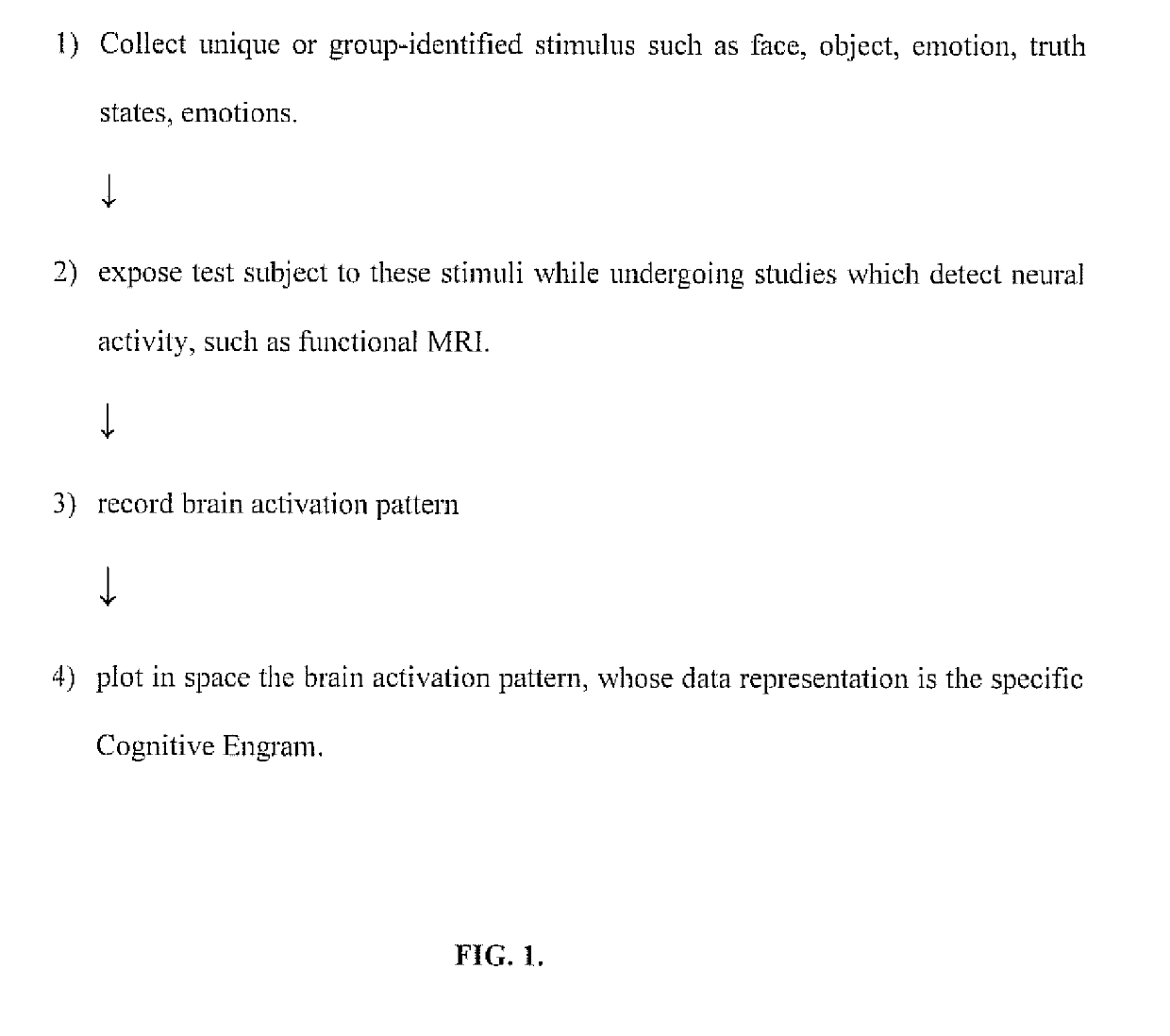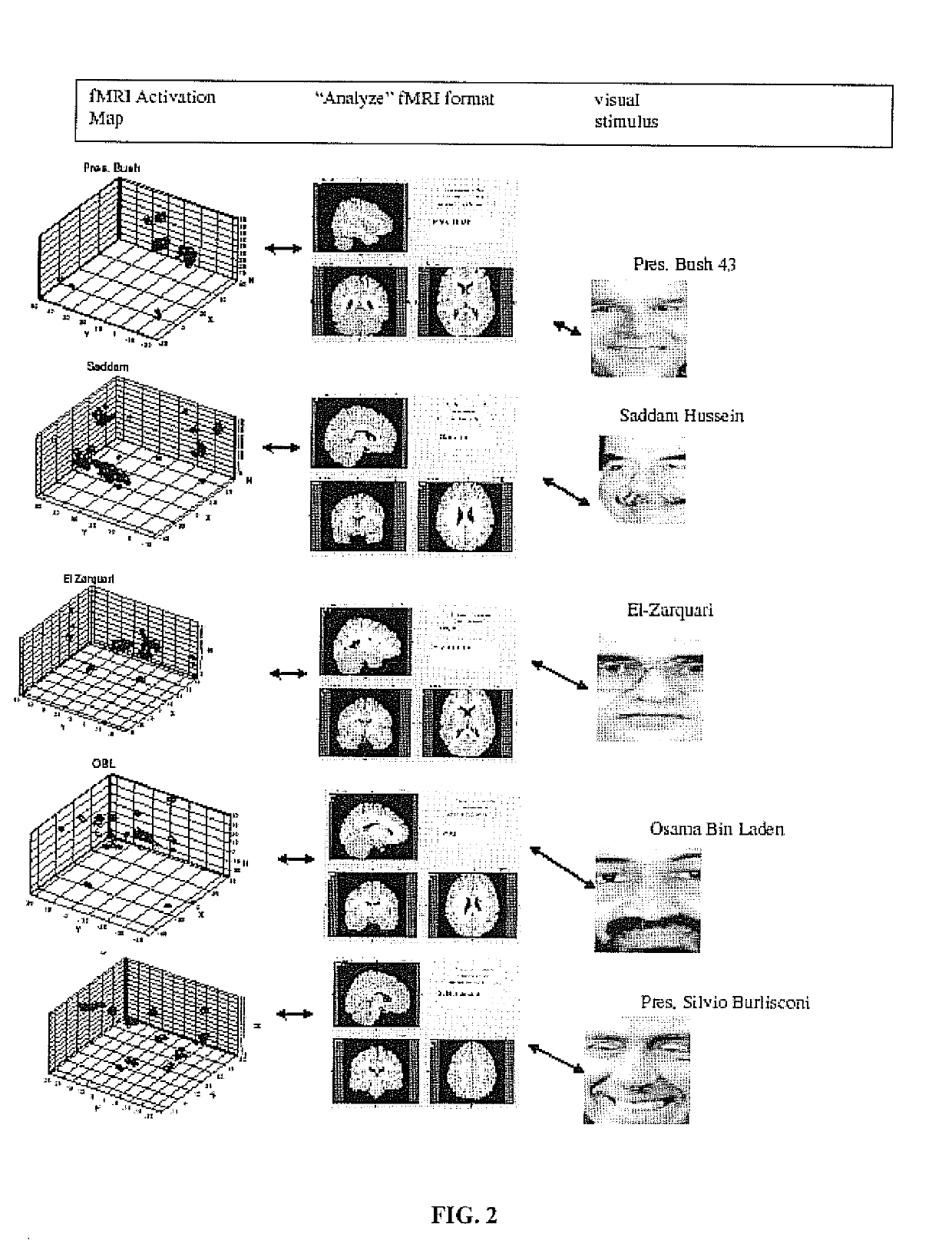Brain function decoding process and system
- Summary
- Abstract
- Description
- Claims
- Application Information
AI Technical Summary
Benefits of technology
Problems solved by technology
Method used
Image
Examples
example 1
[0071]Cognitive Engrams Extracted from Data of Existing Studies
[0072]Recent scientific publications utilizing fMRI to study neurocognitive functions which detail the specific coordinates of activation areas for visual objects were selected, and are described herein. Three-dimensional graphical surface, bubble point or other visual or mathematical representations of the activation maps are constructed by plotting the xyz coordinates. The xyz coordinates were supplied by all three sets of investigators using the normalized space of the Talairach and Tournoux brain atlas (1988), the contents of which are incorporated herein by reference.
[0073]All of the publications whose data is reprocessed presented test objects to test subjects while lying in an MRI scanner, using a flat panel display situated to allow visibility during scanning.
[0074]Bernard et al. (2004), incorporated herein by reference, studied the presentation and processing of visual imaging of famous and non-famous faces. The...
example 2
Distinguishing Cognitive Engrams of Standard Faces
[0077]Healthy adult volunteers consent to an IRB-approved clinical study protocol generally as described by Marks D H, Adineh M, Gupta S: Determination of Truth from Deception Using Functional MRI and Cognitive Engrams. The Internet Journal of Radiology [peer-reviewed serial on the Internet]. 2006. Volume 5, Number 1; incorporated herein by reference. Continual neuroimaging (fMRI) was performed during viewing of the test stimuli to capture structural and functional data. The data was analyzed for the presence of neuroimaging activation shown to correspond to cognition and visual recognition.
[0078]Imaging data were collected in a 3-T General Electric Signa Excite seamier with whole head coil. Changes in the blood oxygen level dependent BOLD T2*-weighted MRI signal were measured using a gradient-echo echoplanar sequence. In each time series 18 (128.times.128) or 28 (64.times.64) contiguous axial slices were obtained. Three sets of scan...
example 3
Sample Interrogation Protocol
[0091]Background information is obtained on the subject's name, age, sex, SSN, birth city, medications, current and past illnesses, psychological history, criminal history, accusation, etc. Then a basic set of standard images is presented to the test subject while undergoing neuroimaging in order to obtain a background pattern of activation. Individual responses to questions are recorded via a number of techniques including verbal responses and pressing of buttons on handgrips. The test subject is presented with between ten to twenty test questions and asked to supply intentionally deceptive and intentionally truthful responses to each question.
[0092]The test subject is presented case-specific questions with accompanying images / displays of words and phrases concerning: Facts about their own personal life, name, sex, age, SSN, residence, criminal history; and Specific photos / questions / statements relating to the subject at issue, including potentially the ...
PUM
 Login to View More
Login to View More Abstract
Description
Claims
Application Information
 Login to View More
Login to View More - R&D
- Intellectual Property
- Life Sciences
- Materials
- Tech Scout
- Unparalleled Data Quality
- Higher Quality Content
- 60% Fewer Hallucinations
Browse by: Latest US Patents, China's latest patents, Technical Efficacy Thesaurus, Application Domain, Technology Topic, Popular Technical Reports.
© 2025 PatSnap. All rights reserved.Legal|Privacy policy|Modern Slavery Act Transparency Statement|Sitemap|About US| Contact US: help@patsnap.com



